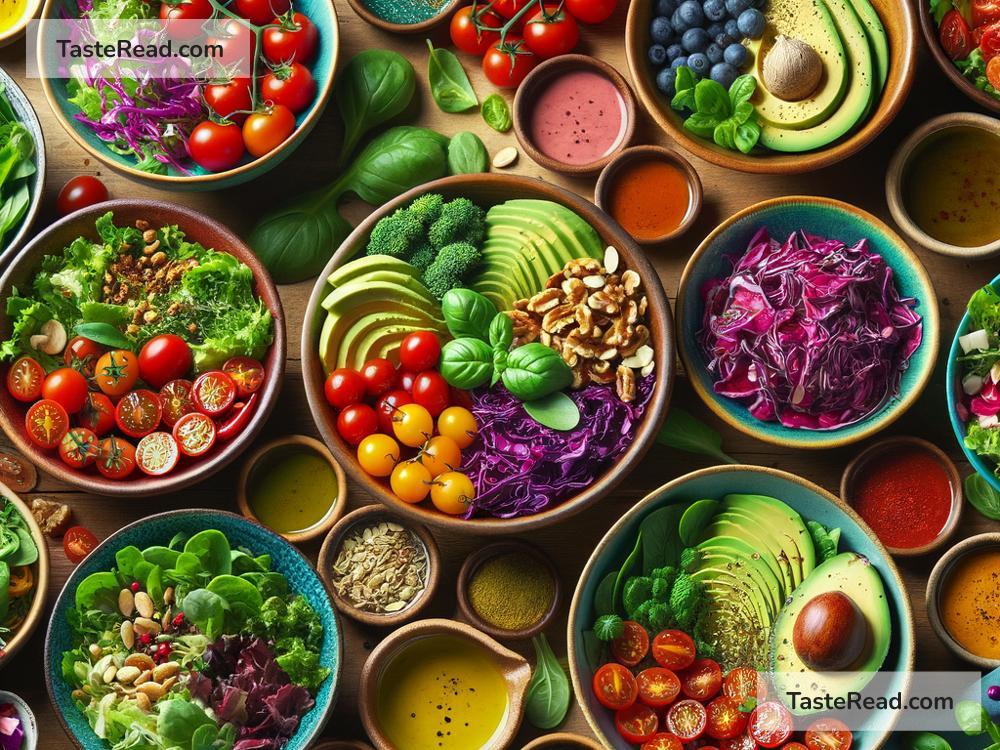How to Combine Colorful Salads: A Simple Guide to Delicious and Healthy Creations
Salads are one of the easiest and healthiest dishes to prepare. They are versatile, refreshing, and can be made with endless combinations of ingredients. One of the best things about salads is how colorful they can be! A vibrant salad not only looks appealing but is also full of nutrients from different vegetables, fruits, and other toppings. If you’ve ever wondered how to create a beautiful, colorful salad, this blog will show you how to mix and match ingredients to make something exciting in every bowl.
Why Color Matters in Salads
When we talk about colorful salads, we’re referring to dishes that include ingredients of different colors like red, green, yellow, orange, purple, and even white. Each color in your salad often represents a different nutrient. For example:
- Red foods like tomatoes and bell peppers are rich in antioxidants (like lycopene).
- Green foods like lettuce, spinach, or cucumbers provide vitamins like vitamin K and are great for your overall health.
- Orange and yellow foods like carrots and mangoes are packed with vitamin C and beta-carotene, which support immune health.
- Purple and blue foods like red cabbage and blueberries contain anthocyanins, which are good for your heart and brain.
- White foods like cauliflower or mushrooms may contain vital nutrients that support immunity and digestion.
Including a rainbow of ingredients ensures that your salad isn’t just pretty but also full of nutrition.
Step-by-Step Guide to Building a Colorful Salad
1. Start with Greens
Every salad starts with a base, and greens are a classic foundation. They provide texture and freshness. Here’s a list of greens you can choose:
- Lettuce varieties (romaine, iceberg, butterhead)
- Spinach
- Kale
- Arugula
- Mixed spring greens
Choose one or mix a few for extra variety!
2. Add Brightly-Colored Vegetables
Vegetables are the heart of any colorful salad. Pick a mix of colors to make your dish exciting and eye-catching! Some popular choices:
- Red: Cherry tomatoes, red peppers, radishes
- Orange: Carrots, sweet potatoes
- Yellow: Corn, yellow bell peppers
- Green: Cucumbers, broccoli, peas
- Purple: Red cabbage, beets
Slice them thinly, dice them, or make ribbons with a peeler for creative presentation.
3. Include Fruity Goodness
Fruits add a burst of sweetness to balance the savory flavors. Some great fruits for salads include:
- Red and Pink: Strawberries, watermelon, raspberries
- Yellow and Orange: Mangoes, oranges, pineapples
- Green: Apples, kiwi
- Purple and Blue: Blueberries, blackberries, grapes
When adding fruits, use them sparingly so they complement, rather than overpower, the flavors.
4. Mix in Proteins
A colorful salad can be made more filling by adding proteins. Proteins also enhance the visual appeal and texture of your dish. Here are some options:
- Plant-based: Chickpeas, tofu, black beans, lentils
- Animal-based: Grilled chicken, boiled eggs, shrimp, salmon
- Cheeses: Feta, goat cheese, mozzarella
Try to pick proteins that pair well with the flavors of your salad without clashing.
5. Add Crunch and Texture
Nobody likes a flat salad! Adding crunchy ingredients can make eating your salad a fun experience. Crunchy toppings include:
- Nuts (almonds, walnuts, sunflower seeds)
- Croutons
- Cucumber or radish slices
- Crispy bacon
The variety in texture will keep your salad interesting and satisfying.
6. Choose a Dressing
The dressing is what ties the whole salad together. Pick one that complements the flavors of your ingredients:
- Light dressings: Olive oil and lemon juice, balsamic vinaigrette
- Creamy dressings: Ranch, Caesar, tahini-based
- Sweet dressings: Honey mustard, poppy seed
You can also make your own dressing by blending olive oil, vinegar, garlic, mustard, and herbs.
7. Optional Add-Ons
If you want to get creative, add fun extras to make your salad stand out. Some ideas include:
- Avocado slices for creaminess
- Pomegranate seeds for a pop of color and sweetness
- Fresh herbs like basil, cilantro, or parsley for flavor
- Edible flowers for elegance
Tips for Combining Ingredients
- Balance flavors: Make sure your salad has a good mix of sweet, salty, tangy, and savory ingredients. For example, pair sweet fruits like mango with salty nuts or cheese.
- Vary textures: Combine crunchy, soft, and chewy items in the same salad.
- Don’t overcrowd: Stick to 6-8 main ingredients so the dish doesn’t feel overwhelming.
- Season your greens: Lightly season your greens with salt and pepper before adding other toppings. This enhances their flavor.
Example Colorful Salad Recipe
Here’s a quick recipe to get you started:
Ingredients:
– Mixed greens (spinach, arugula)
– Cherry tomatoes (red)
– Shredded carrots (orange)
– Sliced cucumber (green)
– Sweet corn kernels (yellow)
– Crumbled feta cheese (white)
– Pomegranate seeds (red)
Dressing:
Mix olive oil, balsamic vinegar, honey, and a pinch of salt.
Instructions:
1. Lay the greens as your base.
2. Arrange the veggies in sections for a pretty presentation.
3. Sprinkle feta and pomegranate seeds on top.
4. Drizzle the dressing and toss just before serving.
Conclusion
Creating a colorful salad is easier than you think! By mixing greens, vegetables, fruits, proteins, and dressings, you can craft a dish that looks beautiful, tastes amazing, and is packed with nutrition. Experiment with new combinations every time, and let your creativity shine. Now it’s time to grab your favorite bowl and start building your masterpiece. Happy salad-making!


